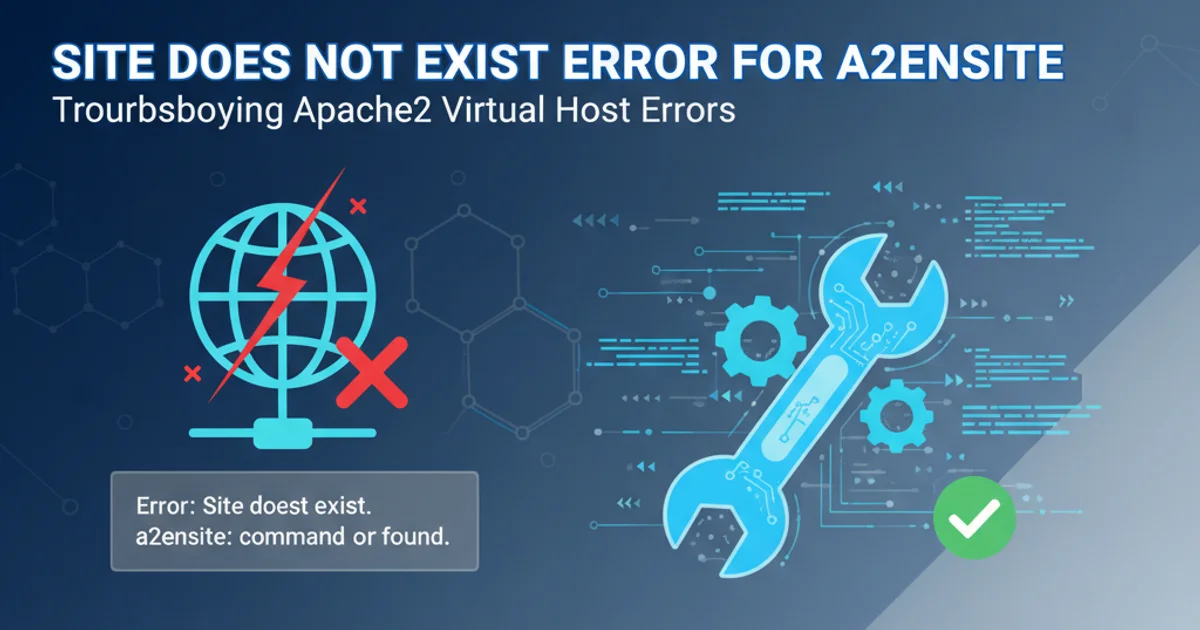Site does not exist error for a2ensite
Categories:
Resolving 'Site Does Not Exist' Errors with a2ensite in Apache2

Learn how to troubleshoot and fix the common 'Site does not exist' error when enabling virtual hosts with a2ensite in Apache2, ensuring your web applications are served correctly.
When configuring Apache2 web servers, a2ensite is a crucial command used to enable virtual host configurations. However, it's not uncommon to encounter the frustrating 'Site does not exist' error. This article will guide you through the common causes of this error and provide step-by-step solutions to get your virtual hosts up and running smoothly.
Understanding the a2ensite Command
The a2ensite command creates a symbolic link from your virtual host configuration file in /etc/apache2/sites-available/ to the /etc/apache2/sites-enabled/ directory. Apache2 then reads the configurations from sites-enabled when it starts or reloads. The 'Site does not exist' error typically means that a2ensite cannot find the specified configuration file in the sites-available directory.
flowchart TD
A[User runs a2ensite] --> B{Check /etc/apache2/sites-available/};
B --"File exists?"--> C{Yes};
C --> D[Create symlink in /sites-enabled/];
D --> E[Success];
B --"File exists?"--> F{No};
F --> G["Error: Site does not exist!"];
G --> H[Troubleshoot];Flowchart of the a2ensite command execution and error path.
Common Causes and Solutions
The 'Site does not exist' error is usually due to one of a few common issues. Identifying the root cause is the first step to a quick resolution.
1. Verify the Configuration File Name and Location
The most frequent cause is a mismatch between the filename you're trying to enable and the actual file in /etc/apache2/sites-available/. Ensure the file exists and its name exactly matches what you provide to a2ensite.
2. Check for Typos in the Command
A simple typo in the a2ensite command itself can lead to this error. For example, a2ensite mywebsite.conf instead of a2ensite mywebsite.conf.
3. Ensure Proper Permissions
While less common for this specific error, incorrect file permissions on the configuration file or the sites-available directory could prevent a2ensite from accessing it. Ensure the Apache user (typically www-data) has read access.
4. Restart Apache2
After successfully enabling a site, it's crucial to restart the Apache2 service for the changes to take effect. This is not directly related to the a2ensite error but is a necessary follow-up step.
Practical Example and Troubleshooting Steps
Let's walk through a scenario where you've created a virtual host configuration and are encountering the error.
<VirtualHost *:80>
ServerAdmin webmaster@localhost
ServerName example.com
ServerAlias www.example.com
DocumentRoot /var/www/example.com/public_html
ErrorLog ${APACHE_LOG_DIR}/error.log
CustomLog ${APACHE_LOG_DIR}/access.log combined
</VirtualHost>
Example virtual host configuration file: example.com.conf
Suppose you saved the above configuration as example.com.conf in /etc/apache2/sites-available/. Now, you try to enable it:
sudo a2ensite example.com
Incorrect command leading to error if file is example.com.conf
This command would likely result in the 'Site does not exist' error because a2ensite expects the full filename, including the .conf extension, if it's present. The correct command would be:
sudo a2ensite example.com.conf
Correct command to enable example.com.conf
After running the correct command, you should see a message indicating the site was enabled and prompting you to reload Apache. Finally, reload Apache to apply the changes:
sudo systemctl reload apache2
Reloading Apache2 to apply new virtual host configuration